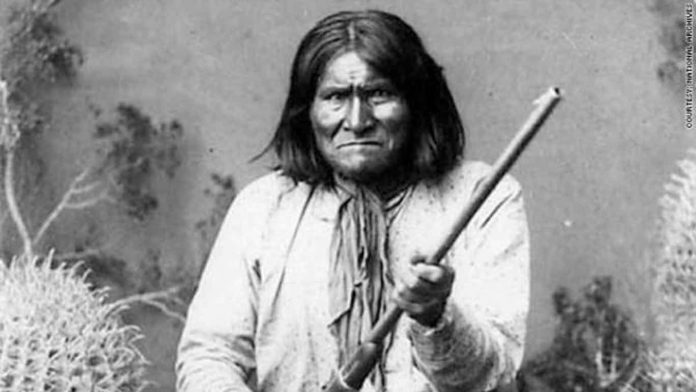On this day – in 1886 – the Apache chief Geronimo surrendered to U.S. forces for the final time.
Geronimo’s surrender marked the end of the Indian wars in the Southwest. It ended 30 years of struggle as the chief battled overwhelming odds to retain his people’s way of life.
Geronimo was born in 1829 and grew up in what is present-day Arizona and Mexico. His tribal name was Goyathlay, meaning “One Who Yawns.”
His tribe, the Chiricahua Apaches, clashed with non-Indian settlers trying to take their land.
In 1858, Geronimo’s mother, wife and three children were murdered by Mexicans. Seeking revenge, he later led raids against Mexican and American settlers. He joined a long list of great Apache chiefs fighting for freedom, including Mangas Coloradas, Cochise, Nana and Victorio.
The mere mention of Geronimo’s name caused ranchers and prospectors to abandon their work and seek safety at nearby forts or in towns. But even booming towns like Tombstone were frequently on high alert, fearing an Apache raid.
Geronimo’s name became legendary. Some claimed that he was a shapeshifter, able to turn himself into an animal to escape his foes.
In 1874, the U.S. government moved Geronimo and his people from their land to the San Carlos Reservation in Arizona. But, conditions on the reservation were restrictive and harsh and Geronimo and some of his followers escaped.
Over the next decade, they battled federal troops and launched raids on white settlements. During this time, Geronimo and his supporters were forced back onto the reservation several times. In May 1885, Geronimo and approximately 150 followers fled the reservation.
They were pursued into Mexico by 5,000 U.S. troops. In March 1886, Gen. George Crook forced Geronimo to surrender; however, Geronimo – with only 38 followers – quickly escaped and continued his raids.
General Miles then took over the pursuit of Geronimo, eventually forcing him to surrender, on Sept. 4, 1886, near Fort Bowie along the Arizona-New Mexico border.
Geronimo and other Apaches – including the Apache scouts that helped the army track him down – were sent to Florida and then Alabama, as prisoners of war. They were eventually allowed to go to the Comanche and Kiowa reservation near Fort Sill, Oklahoma.
There, Geronimo became a successful farmer and converted to Christianity. He participated in President Theodore Roosevelt’s inaugural parade in 1905. But he would never be allowed to return to his Apache homeland.
Returning home drunk one winter’s night, the Apache chief fell from his horse and ended up in icy water. He spent the night on the cold ground and caught pneumonia. Geronimo died at Fort Sill on February 17, 1909.













